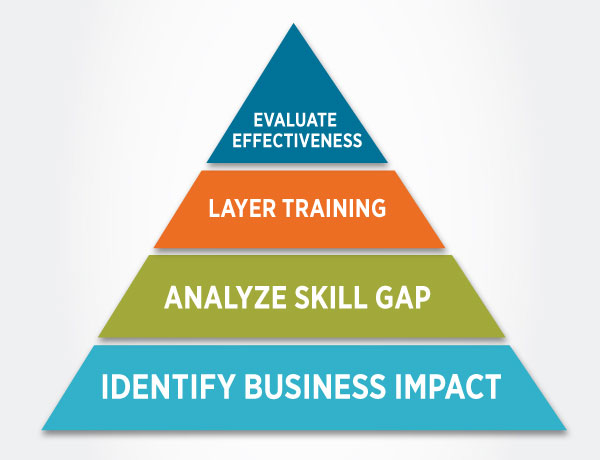
Organizational Training
![]()
Employee Training is a program that helps employees learn specific knowledge or skills to improve performance in their current roles. Development is more expansive and focuses on employee growth and future performance, rather than an immediate job role.
Why do you need
high-impact employee training and development?
Good training and development programs help you keep the right people and grow profit. As the battle for top talent becomes more competitive, employee training and development programs are more important than ever. Hiring top talent takes time and money, and how you engage and develop that talent impacts retention and business growth. For example, Great Place to Work® found that employee development, more than any other area, was identified by the 2014 100 Best Companies as a top area of focus.
According to China Gorman, CEO at Great Places to Work, “As companies grow and the war for talent intensifies, it is increasingly important that training and development programs are not only competitive, but are supporting the organization on its defined strategic path.” And it’s not just about retention. Employee training and development programs directly impact your bottom line.
In their Predictions for 2015, Bersin by Deloitte said, “Organizations with high-impact learning delivered profit growth three times greater than their competitors. Why is this? Simply put—if you can keep your employees current and skilled, you can evolve and perform better than your competitors.”
How do you create
high-impact employee training?
High-impact training and development programs don’t just happen. Instead, they’re the result of a careful planning and alignment process. The following steps can help you translate business objectives into a tailored training plan
- Identify Business Impact
- Analyze Skill Gaps
- Layer Training Methods
- Evaluate Effectiveness and Sustain Gains
- Motivation: How can you help learners understand why they need to change their behaviors? By working with employee motivations, you’re more likely to change behavior over the long term.
- Skills Mastery: What do your learners need to be able to do on the job? These behaviors will have the most impact on performance.
- Critical Thinking: What must your learners know to perform their jobs? Distinguish critical knowledge from nice-to-know info to identify what content should be in the course, and what should be in optional resources.
Outbound Training

Experiential Learning is the best way to learn. One of the most unique aspects of outbound training is that one is immediately able to see the consequences of wrong actions and can see the tangible difference that can be made by a change in thinking and behavior.
In our outbound programs, participants are made to go through various outdoor activities where they are required to face challenging situations as individuals and as teams. This helps them to see the importance of communication, leadership, teamwork, planning and delegation.
SMI focuses on removing professionals from their comfort zone and placing them in psychologically and physically challenging environments. The primary focus here is developing presence of mind, collaborative learning, creative problem solving through the use of limited resources.
A list of programs that organizations usually prefer using the ‘Outbound’ methodology is given below:
- Sales Training
- Leadership Development
- Building the Team
- Motivation
- Problem Solving
- Various Activities for Overcoming Fear
It improves one to do a self assessment, increase organizational bonding and the effectiveness of the same is huge.
Helps a Team in:

- Unlocking the potential of team members.
- Motivating team members by linking to their individual motivators.
- Improving team performance by leveraging complementary skills.
- Building common vision, values and team spirit.
- Increased collaboration, innovation and productivity.
- Learning importance of open communication, developing team strategies for getting results, building trust, giving and receiving feedback.
For further details click here
Helps an individual in:

- Relationship building, earning trust, respect and leading by example.
- Aligning goals of organization, team and individuals.
- Personal development contributing to humility, effectiveness, innovation, managing change, enhancing creativity, problem solving skills, performing in complex situations, maintaining work-life balance.
- Developing self-confidence, positive attitude, motivation.
- Reaching peak performance levels.
- Understanding about courage, fears, risk taking, fighting new challenges.
- Identifying one’s key drivers and differentiators.
- Overcoming conflict, open communication.
- Managing time, anger and stress.
Advantages and benefits of high-impact employee training
To help organizations stay competitive as well as excel, here are few popular programs from the house of SMI that has delivered high impact transformational excellence.
- Business Etiquette & Grooming
- Communication Skills
- Presentation Skills
- Art of Effective Delegation
- Interpersonal Skills
- Goal Setting
- Assertiveness
- Conflict Resolution
- Personality Development
- Personal Effectiveness
- Planning & Time Management
- Sales Effectiveness
- Basic Negotiation Skills
- Coaching and Mentoring
- Problem Solving and Decision Making
- Creativity and Innovation (TRIZ & TOC)
- Customer Service (Internal / External)
- Emotional Intelligence
- Women Empowerment
- Interviewing Skills
- Leadership Skills
- Managerial Skills
- Stress Management & Work life Balance
- Neuro Linguistic Programming
- Customized Training Programs

